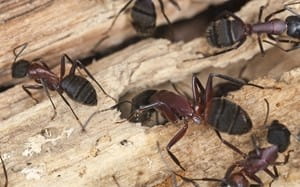
Carpenter ants are one of the most common pests found in homes. Not only are they an extreme annoyance, but they can cause damage to wood by hollowing it out and using it as a place to reside. To keep them from destroying your home, it's important to practice efficient control and prevention.
Here are few tips for how to get rid of carpenter ants and how to prevent them from returning.
Inspect the potential areas
The first step to controlling your carpenter ant problem is performing proper inspection. Locate the nests by checking on the following sites:
If you have inspected the possible areas and found where the carpenter ants have been residing, it's time to determine which method of control you're going to use.
Baiting - Carpenter ant baits are designed to attract the pests. The ants pick up the poisonous bait and usually share it with their colony, ultimately eliminating them. Covering voids - Indoor voids, or nests, are often found in hollow areas, such as doors or window sills. Fill the nests with foams or dusts to get rid of the problem.
Spraying - Consider using a non-repellent insecticide to get rid of the carpenter ants.
Once you've taken the measures to eliminate your carpenter ant problem, it's crucial to practice prevention to reduce the chance of gaining pests in the future. The Department of Entomology at the University of Kentucky suggested following these tips for carpenter ant prevention:
Fix leaks - Correct any moisture problems, roof or plumbing leaks in your home that may attract carpenter ants in the future.
Get rid of wood - Diminish wood-to-ground contact, such as mulch touching your siding to avoid making it easier for ants to enter your home.
Cut down trees - Get rid of the tree branches or vegetation that may be touching your home. The source said these elements act as bridges for the carpenter ants to get onto your house.
Seal cracks - Seal any openings to the foundation of your home.
Store firewood far - Keep firewood far away from the foundation of your home. It may look like an appealing home for carpenter ants, which poses a greater threat on them entering your home.